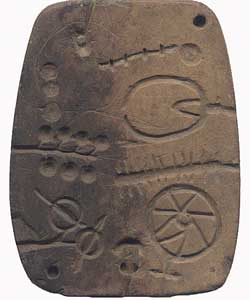The Political Landscape: Smith’s research offers new view of how states emerge
By Seth SandersNews Office
 Above is a photograph of the shrine discovered at the Gegharot Fortress last summer by Adam Smith. The photo below shows one side of the stone mold used for making bronze jewelry. | |
 | |
Whether on urban streets patrolled by police cars outside City Hall, or in rural places that urban imaginations fill with amber waves of grain and uniformly conservative voters, American landscapes are political. Power is played out in both real and imaginary places, in city and countryside alike, and yet images of landscapes are often viewed as vague, boring and safe.
When Russian artists Komar and Melamid surveyed people to find out what kind of painting they liked best, the most popular response, regardless of race, class and gender, was “a landscape.” Adam Smith, Assistant Professor in Anthropology and the College, points out in his new book, The Political Landscape, that although landscape images in the modern European tradition have been identified as the most innocent of all kinds of painting, such representations used to look a lot more political.
In ancient Assyrian reliefs, bodies impaled on spikes look out over rivers flooded with corpses, as the king of Assyria puts his foot down on another king’s throat. In his book, Smith asserts that gory Assyrian and safe European images serve some of the same political purposes. In European landscapes “all the blood’s been washed away,” he says, “but it’s still an operation of politics.” Late 18th- and 19th-century English paintings, he notes, featured rustic countrysides with small farmhouses and rural lanes—at the exact same time that new enclosures gobbled up lands and placed them in the hands of a landed elite. Safe, comforting images can serve political purposes, too.
“Politics,” he explains, “is a fight over landscapes. The most successful politicians know very precisely that politics is about space and the movements of physical things and people, but the scholarly world hasn’t entirely figured this out yet. The way you plot presidential campaigns, for example, is almost entirely spatial and temporal, about specific voters in specific states on specific days.”
Smith’s new angle affords nothing less than a new perspective on how states emerged and developed. His book explains that the old “social evolutionist” model, which predicted tidy, step-by-step progress, from little bands to bigger tribes to budding chiefdoms to full-fledged states, did not happen that way.
What he found in his research instead was that around 2000 B.C.E., stable agricultural villages were replaced by predominantly nomadic societies where animal husbandry and martial heroics dominated daily life. The primary sign of emerging social inequality was the increasing number of luxurious graves built for a new elite. Then, around 1500 B.C.E., that inequality was quickly and tightly solidified as stone-walled fortresses appeared, topped by new institutions, including palaces and temples, where metals were worked into luxury goods and traded. “What’s going on in Eurasia, and particularly Caucasia, goes against all the fundamental models that we’ve developed from major centers of ‘civilization,’ such as Mesopotamia or the Maya lowlands.”
In Mesopotamia, civilization built slowly and gradually, moving from villages to cities and persisting over hundreds and thousands of years. But in the Caucasus, clusters of large towns are ephemeral. “Unlike in the Near East, they just rise, flourish and disappear,” says Smith.
Smith uses a spectrum of technologies to explore, map and communicate how and where these changes became real. A fortress in central Armenia known as Gegharot, built around 1500 B.C.E., typifies the constellation of religious, economic and political power that allowed this early state to rise. Gegharot stands as an emblem for the challenge it poses to older models.
Smith’s computer displays images of artifacts found in the fortress, such as a mold for making bronze jewelry that was discovered on the floor of a temple, for example. Other images reveal the same room littered with storage jars that may have contained goods sent to Gegharot as tribute to the gods worshipped there, an indication of the new power of institutions to command significant portions of the regional economy.
“The fortress of Gegharot arose near the very beginning of complex polities in Caucasia, in the mid-second millennium,” Smith says.
The bigger picture is becoming clearer. The old model of how society “must” evolve is based on the fact that archaeologists were familiar with only one type of society.
In the region Smith studies, he says, “polities don’t evolve, they shape themselves by shaping their landscape to forward both new and traditional political ends.
“In many respects, the early political history of Caucasia is the anti-Mesopotamia. Complex polities with profound social inequality and robust institutions of rule do not emerge from long periods of settled agricultural villages, which give rise to distinct centers of authority, such as temple and king,” Smith explains.
“Instead, they appear rather suddenly out of a highly nomadic social world, and their institutions are not discrete—they are part of a tightly bundled package where political, religious and economic power appear to be almost synonymous.
“And 700 years later, the Urartian Empire unifies much of the highlands of southern Caucasia and eastern Anatolia, and it looks very much like these early small fortress-polities—which are the foundation of a Caucasian political tradition, in which a tightly integrated political authority apparatus provides a basis for civil society.”
This picture of ancient fortresses rising from a nomadic plain is a landscape, too, but, as Smith shows, one with new historical significance.
As an editor of the collection Archaeology in the Borderlands and a co-director of the joint American-Armenian Project for the Archaeology and Geography of Ancient Transcaucasian Societies, Smith is helping to present this image in print and on the Internet.
He already has shown its significance for the history of political life, and in The Political Landscape, he suggests that its consequences may be broader yet.
![[Chronicle]](/images/sidebar_header_oct06.gif)